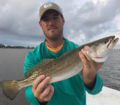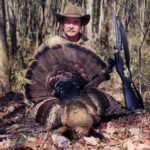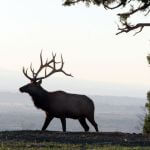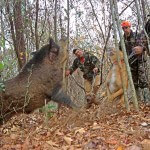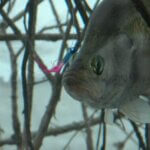John’s Note: October speckled trout hold on two types of reefs – public reefs and semi-public reefs. Public reefs consist of manmade reefs, oyster reefs or other types of bottom structure that everyone has pinpointed. The same kinds of structures that fewer folks know about comprise semi-public reefs. However, even if you choose to fish a semi-public reef in hopes that you’ll have the fish all to yourself, you won’t keep that spot secret for long. Coastal waters have become so heavily fished that few secret fishing spots remain. If you fish a reef near a large concentration of fishermen, the other anglers will see you fishing that reef and learn of its location. If you catch several speckled trout on that reef and anyone sees you, then your secret’s out. Therefore, we need to learn how to fish reefs that experience only a small amount of fishing pressure as well as reefs that have so many boats on them you can almost step from one boat to the next. To learn more about Alabama’s fishing reefs, go to http://www.outdooralabama.com/artificial-reefs.
How to Use Fishing Pressure to Your Advantage:
Anglers usually will find the least amount of fishing pressure on any reef during the first hour and a half of daylight. In that magic window of time, few anglers will fish any known trout hot spot. When the sun comes-up, the reef will begin to load up with trout fishermen dropping anchors, talking loudly, throwing fish in the bottoms of boats and spooking every speckled trout around off that reef. That’s when those fishermen won’t catch trout, but you can.
 “When those noisy fishermen move on the reef, the trout will move 100- or 200-yards away from the reef,” says Captain Gary Davis of Magnolia Springs, Alabama, who fishes seven manmade artificial reefs inside Mobile Bay on Alabama’s Gulf Coast out of Fort Morgan Marina. “When the other fishermen come to the reef, I’ll back away from the reef and look for slicks. The speckled trout and the baitfish will move away from the reefs out into open water. The trout will catch, kill and eat the baitfish, and the oil from the bodies of the baitfish will rise to the surface, creating a slick spot on the water. The school of trout that’s feeding and moving generally will be out in front of the baitfish and anxious to feed.”
“When those noisy fishermen move on the reef, the trout will move 100- or 200-yards away from the reef,” says Captain Gary Davis of Magnolia Springs, Alabama, who fishes seven manmade artificial reefs inside Mobile Bay on Alabama’s Gulf Coast out of Fort Morgan Marina. “When the other fishermen come to the reef, I’ll back away from the reef and look for slicks. The speckled trout and the baitfish will move away from the reefs out into open water. The trout will catch, kill and eat the baitfish, and the oil from the bodies of the baitfish will rise to the surface, creating a slick spot on the water. The school of trout that’s feeding and moving generally will be out in front of the baitfish and anxious to feed.”
 To catch these fish, Davis uses grubs, D.O.A. (http://www.doalures.com/) shrimp, live shrimp and live croakers. “My favorite bait is the D.O.A. shrimp,” Davis explains. “Because it’s an artificial lure, I don’t have to worry about rebaiting when the trout attack.” Davis casts the D.O.A. shrimp out on 10-pound-test line and lets the shrimp fall to the bottom on a slack line. Because this plastic shrimp has a small piece of lead on the hook in the belly of the shrimp, the lure swims to the bottom just like a live shrimp. Therefore, any action you give the bait detracts from the effectiveness of the lure. According to Davis, “I just watch my line as the shrimp runs with the current, without giving it any action. “Then when the trout attacks, the line I use will twitch or jump. That’s my signal to set the hook to catch the trout.”
To catch these fish, Davis uses grubs, D.O.A. (http://www.doalures.com/) shrimp, live shrimp and live croakers. “My favorite bait is the D.O.A. shrimp,” Davis explains. “Because it’s an artificial lure, I don’t have to worry about rebaiting when the trout attack.” Davis casts the D.O.A. shrimp out on 10-pound-test line and lets the shrimp fall to the bottom on a slack line. Because this plastic shrimp has a small piece of lead on the hook in the belly of the shrimp, the lure swims to the bottom just like a live shrimp. Therefore, any action you give the bait detracts from the effectiveness of the lure. According to Davis, “I just watch my line as the shrimp runs with the current, without giving it any action. “Then when the trout attacks, the line I use will twitch or jump. That’s my signal to set the hook to catch the trout.”
When Davis or his party gets a big trout on the line, he encourages his fisherman to keep his rod tip in the water, play the trout down and bring the fish slowly to the net. He also tells the lucky angler not to jump up and down and get excited when a big, 4-1/2- to 8-pound trout comes on-board. “I try to keep the fish low in the boat, so that the other anglers on the reef can’t see the size and kind of trout that we’re catching,” Davis emphasizes. “I don’t want to get the fishermen on that public reef to come over and fish the school of trout that I’m fishing because they will usually spook the fish. Then I’ll have to go find another slick to fish.”
 To meet even more captains and fishermen before you visit Alabama’s Gulf Coast, visit my YouTube channel. To learn more about inshore fishing, go to https://www.amazon.com/Alabamas-Inshore-Saltwater-Fishing-Year-Round-ebook/dp/B009EZR046/ref=asap_bc?ie=UTF8 for John’s book, “Alabama’s Inshore Saltwater Fishing.” For more information about John E. Phillips’ fishing and hunting books, check out www.amazon.com/author/johnephillips and www.barnesandnoble.com.
To meet even more captains and fishermen before you visit Alabama’s Gulf Coast, visit my YouTube channel. To learn more about inshore fishing, go to https://www.amazon.com/Alabamas-Inshore-Saltwater-Fishing-Year-Round-ebook/dp/B009EZR046/ref=asap_bc?ie=UTF8 for John’s book, “Alabama’s Inshore Saltwater Fishing.” For more information about John E. Phillips’ fishing and hunting books, check out www.amazon.com/author/johnephillips and www.barnesandnoble.com.
Next: Learning More about Public Reef Speckled Trout

